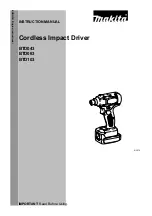
11
Tightening bolts
The proper fastening torque may differ depending upon the kind or size of the
screw/bolt, the material of the workpiece to be fastened, etc. The relation
between fastening torque and fastening time is shown in the figures.
NOTE:
•
Use the proper bit for the head of the screw/bolt that you wish to use.
•
When fastening screw M8 or smaller, carefully adjust pressure on the
switch trigger so that the screw is not damaged.
•
Hold the tool pointed straight at the screw.
•
If you tighten the screw for a time longer than shown in the figures, the
screw or the point of the driver bit may be overstressed, stripped,
damaged, etc. Before starting your job, always perform a test operation
to determine the proper fastening time for your screw.
CAUTION:
•
If the tool is operated continuously until the battery cartridge has
discharged, allow the tool to rest for 15 minutes before proceeding with a
fresh battery.
The fastening torque is affected by a wide variety of factors including the fol-
lowing. After fastening, always check the torque with a torque wrench.
1.
When the battery cartridge is discharged almost completely, voltage will
drop and the fastening torque will be reduced.
2.
Driver bit or socket bit
Failure to use the correct size driver bit or socket bit will cause a reduc-
tion in the fastening torque.
3.
Bolt
•
Even though the torque coefficient and the class of bolt are the
same, the proper fastening torque will differ according to the
diameter of bolt.
•
Even though the diameters of bolts are the same, the proper
fastening torque will differ according to the torque coefficient, the
class of bolt and the bolt length.
4.
The manner of holding the tool or the material of driving position to be
fastened will affect the torque.
5.
Operating the tool at low speed will cause a reduction in the fastening
torque.
Hammer drilling operation
CAUTION:
•
There is a tremendous and sudden twisting force exerted on the tool/bit
at the time of hole break-through, when the hole becomes clogged with
chips and particles, or when striking reinforcing rods embedded in the
concrete.
To drill in the concrete or tiles, first, turn the action mode changing lever so that
the arrow on the lever points to the
mark on the tool body. The adjusting
ring can be aligned in any torque levels for this operation.
Be sure to use a tungsten-carbide tipped bit.
Position the bit at the desired location for the hole, then pull the switch trigger.
Do not force the tool. Light pressure gives best results. Keep the tool in posi-
tion and prevent it from slipping away from the hole.
Do not apply more pressure when the hole becomes clogged with chips or
particles. Instead, run the tool at an idle, then remove the bit partially from the
hole. By repeating this several times, the hole will be cleaned out and normal
drilling may be resumed.
120
100
80
60
40
20
Standard bolt
N m
F
astening torque
Fastening time
S)
Proper f
astening torque
(kgf cm)
(1224)
(1020)
(816)
(612)
(408)
(204)
(
0
1.0
2.0
3.0
(M14)
(M12)
(M10)
(M8)
0
M14
M12
M10
M8
007318
120
100
80
60
40
20
High tensile bolt
N m
F
astening torque
Fastening time
S)
Proper f
astening torque
(kgf cm)
(1224)
(1020)
(816)
(612)
(408)
(204)
(
0
0
1.0
2.0
3.0
(M12)
(M10)
(M8)
M12
M10
M8
007320
Summary of Contents for BTP140
Page 15: ...Memo 15 ...
Page 16: ...Makita Corporation Anjo Aichi Japan 884655 223 ...


































